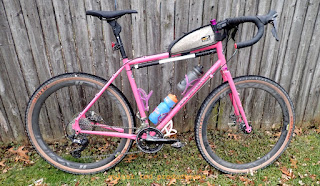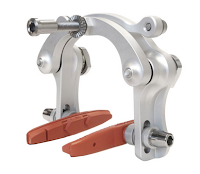 |
| How do my ideas from a decade ago stack up with what is available today? |
We had three types of bicycles in those days: Road racing styled bikes, mountain bikes, and touring/cyclo cross bikes. There were elements of all of these bikes which I liked from my perspective, and this might be a good time to mention something regarding perspective.
It was my perspective. This "concept bike" nonsense was never meant for anything other than my own personal goals for realizing a "better tool for the job". Whether or not anyone else was going to like it, or want it, was not my concern at that time. I had ideas that I was sure would be far better than what I had available to me at that time. Now, of course, if other people happened to like the idea, well.....okay. That would be great. But make no mistake- I was going to end up with a bicycle like this regardless. That the folks out there doing what I was doing ended up- more or less- on a similar page is amazing and cool. Totally not my plan though.
Now, back to the bike choices. I liked a few things about road geometry because, well, we were riding on roads, not single track. So, while mountain bike tires with their cushy, comfortable, and stable ride were attractive, the geometry of those bikes weren't lending themselves to a ride mainly in the saddle for hours at a time. The road bikes were a bit too "racy" though, and this was/is because paved roads which are smooth, don't require any concessions to stability or comfort which you have to have on rougher, looser surfaces like gravel and sometimes dirt. Not to mention that tire clearances on road racing based bikes was severely limited. It's interesting to note now how gravel riding has actually influenced the road racing bikes of 2020, many of which can now handle a 32mm-35mm tire. This was unheard of - no, it was unthinkable - ten years ago.
Cyclo cross bikes did have adequate tire clearances in may cases, but the specific nature of their design meant that they had certain features which did not translate well to long days in the saddle. CX bikes were meant for clearing barriers, pedaling in deep ruts, and had to be able to carve tight corners at slow speeds. Plus, efficiency was king, meaning any concessions for rider comfort were secondary, or not considered into their design. I recall many "pure" CX bikes in the 90's didn't even have water bottle bosses. Those were things that just got in the way.
 |
| I used to use mountain bikes on gravel, but it wasn't completely ideal. |
One could make an argument for touring bikes here. They have the geometry, the tire clearances, and the capability for carrying necessities, but there are a couple things about them that were not what I wanted at all. First and foremost, any touring bike worth its salt is going to be designed to handle and ride best when fully loaded. This means that when the touring bike is unladen it rides differently. Without panniers and bags full of gear, the touring bike frame becomes a stiff beast which isn't fun to ride on for very long on rougher roads. Secondly, the chain stays on touring bikes are a bit cartoonishly long so that when bags are mounted on the rear, there is clearance for legs and feet. We aren't going to be needing panniers on gravel bikes, so my take was that the chain stays could be shorter and the frame tubing could be more forgiving without having 75lbs of gear strapped to it.
What I was after was an amalgam of all of the good things from all of the above bikes. Here were my parameters which I listed back in 2010.
- 71.5 degree head angle. (Could go to 72, but we'll see.)
- 73 degree seat angle.
- 50mm offset fork (Could change)
- Low bottom bracket height. (Something around 75-80mm drop)
- Not touring length chain stays, but not cyclo-cross short either.
- Room for 42mm tires
 |
| Paul Components Racer brake (Center mount style shown) |
So, here was the idea Ben and I had. Crazy as it may sound. We wanted to use the braze on vesion of the Racer brake because it uses mounting posts which attach closer to the fork crown, allowing the blades to have an uninterrupted tube for better compliance from the drop out to the fork crown. Plus, the braze on makes the Racer brake more responsive. Now, here's the kicker. This is where minds get twisted and people think Ben and I are crazy.
The rear Racer brake we wanted to have with the same braze on mounts, but located under the chain stay, like some older mountain bikes do.
I can hear you all now screaming at your glowing screen that this is a stupid, idiotic idea. "What about mud! That's a horrible place for a brake!" Or.....is it? Here's why we wanted to do this, if you haven't already figured it out. We wanted brake-free seat stays for the best rider comfort we could get. In fact, we were going to spec the lightest, thinnest seat stay tubing that we could. Also, with the brake mounted to the chain stay, you get massive brake response. Hardly any flex there! And a shield could be made, ala Charlie Cunninham's ideas (many examples shown here) to ward off dust and debris. With fenders, this would be even less of an issue.
So, there are the reasons and the background for the 2010 concept bike. Next time we will see where these ideas, (minus the oddball brake ideas, of course) fit into today's scene and what I would do differently now if I were to have this bike built.

3 comments:
Thank you for that Cunningham link today. That brought back some wonderful memories for me.
I have a 1980's version of the Marin Bear Valley with chain stay mounted center pull brakes. I refuse to let it go because of the superior ride characteristics. You wouldn't believe how many people have looked at me funny when I say brakes mounted on the seat stays interfere with the ride. I also feel that racks mounted to the seat stays mess the ride characteristics for similar reasons.
The Scott Solace, an endurance road bike, used to sport chainstay-mounted rim brake calipers, before Scott redesigned it for disc brakes.
You can see some pictures here: https://www.theproscloset.com/products/2015-scott-solace-30-road-bike-58cm-xl-carbon-shimano-105-compact
The argument for it was the same as yours: They could use super thin carbon seat stays for better ride quality.
Post a Comment